Tomar - Accessible Tour
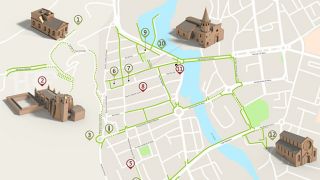
Tomar is usually known as the "Templar City", an allusion to the fundamental role that the Order of the Knights Templar had in its development and that it founded here the castle and the Convent of Christ, classified as World Heritage by UNESCO.
Download the map and follow the tour
This cluster of monuments that is situated on one of the highest points of the city, is the first step on the journey that we are suggesting for you. From the historic centre of the city, the access is along Avenida Dr Vieira Guimarães, a pretty steep road without footpaths or crossings, which means it is not very safe, so it’s best to do this journey by car or take one of the TUTomar buses, adapted for people with limited mobility. Along the route is the Ermida de Nossa Senhora da Conceição (1), a small chapel in Renaissance style, not always open for visits and whose access is hampered by a small flight of steps.

Photo: Convento de Cristo, Tomar @ Shutterstock_kelifamily
To visit the Convent of Christ (2), which, given the construction periods it covers, is like a genuine lesson in the history of art, it is advisable to book in advance to find out about the special conditions available. Persons with impaired mobility should opt for the north façade entrance of the convent, which gives access to the ground floor where there are routes with access ramps for wheelchair users and a service elevator for reaching the first floor. For the blind and visually impaired there is a visit supported by audio-guides and a route where they can feel the shapes and textures of the architecture.
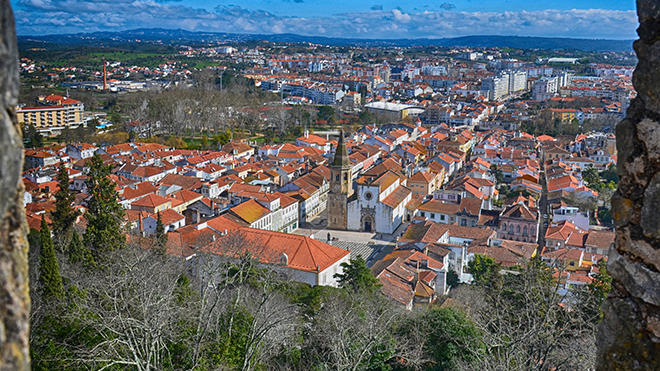
Photo: Tomar@Shutterstock_Alena Zharava
Next to the convent, is the Mata Nacional dos Sete Montes (Seven Hills Woods) (3), a very pleasant green area accessible to all, entered from Avenida Dr Vieira Guimarães, the same road that takes you back to the centre of Tomar. The next stage of the visit is on the south side of the city and is the interesting Museu dos Fósforos (Match Museum) (4), which is in the Convent of São Francisco (5), an accessible monument that offers visits adapted for people with impaired mobility. Then you can continue to the Church of Santa Maria do Olival (12), a benchmark of Portuguese Gothic architecture. The right side entrance has a ramp and provides access to the inside of the church, which, like the outside, is quite simple and houses the tombs of some Masters of the Order of the Templars.
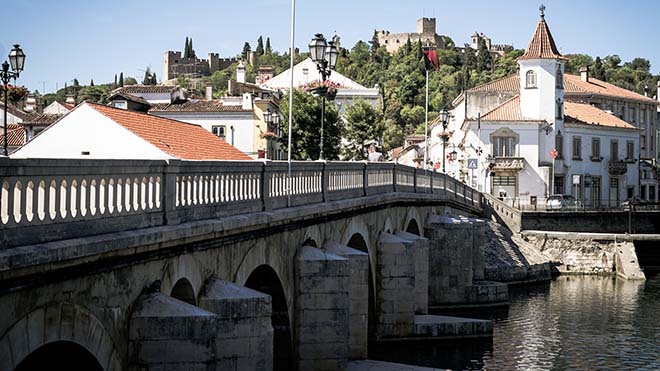
Photo: Tomar@Shutterstock_CN_Marvlc
The route continues toward the Church of Santa Iria (11) dedicated to the patron saint of the city. It cannot be visited completely independently since the entrance has steps and there are some barriers inside. This church stands on the bank of the River Nabão, which crosses the city providing stunning views and a freshness that is much appreciated on hot days. Its waters, contained by various dykes form several planes and surround the Mouchão Park (10), a fully accessible area that is very popular as a place to relax for a while. Nearby, another place not to be missed - the Municipal Museum’s Centre for Contemporary Art (9), which is fully accessible and offers visits adapted to the needs of persons with impaired mobility.

Photo: Igreja de São João Baptista, Tomar @ ARPT Centro de Portugal
The last part of the itinerary goes through the most central area of the city, a group of flat streets which do not present major difficulties. Right in the centre is the Praça da República (6), the point of convergence of the splendid parades of the Festa dos Tabuleiros (Festival of the Trays) which is held every four years. This is where we find the Igreja Matriz (Main Church) (7) dedicated to St John the Baptist, whose beautiful Manueline doorway gives entry to a spacious interior, without barriers. Nearby, in Rua Dr Joaquim Jacinto, a narrow street with an uneven surface is the Synagogue, today the Abraham Zacuto Luso-Hebraico Museum (8). It houses a valuable epigraphic and documentary collection in a large area without any barriers that is accessed by negotiating one step.
The route that we suggest ends here, in what is the busiest part of the city, where you will find a number of traditional shops, as well as coffee shops that feature the finest local confectionery, in particular the "Fatias de Tomar” (Tomar slices), which can be a good way to round off, and replace the energy spent on wandering round the city.
.



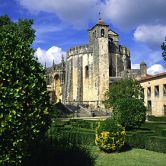
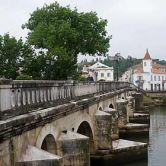



 Explore
Explore 
 Remember and Share
Remember and Share 


